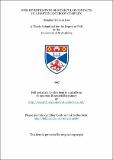Files in this item
NMR investigation of molecular contacts in a hapten-antibody complex
Item metadata
| dc.contributor.advisor | Homans, S. W. | |
| dc.contributor.author | Low, Douglas Graham | |
| dc.coverage.spatial | 210 p. | en_US |
| dc.date.accessioned | 2018-06-13T09:03:14Z | |
| dc.date.available | 2018-06-13T09:03:14Z | |
| dc.date.issued | 1996 | |
| dc.identifier.uri | https://hdl.handle.net/10023/13986 | |
| dc.description.abstract | An antibody Fv fragment was cloned from hybridoma cells of a monoclonal antibody against the steroid derivative estrone-3-glucuronide (E3G). The detection of this molecule is important in a method for predicting fertility. The variable heavy and light chain genes were isolated and amplified and placed into a modified pUC 19 vector to allow expression of active protein. The immunochemistry of the fragment was determined by ELISA, demonstrating that the fragment did bind E3G, that this binding was specific, the antibody fragment competed against the parent monoclonal antibody, and that the fragment could inhibit binding of the monoclonal antibody to an E3G-alkaline phosphotase conjugate. The expression of the fragment in E. coli was optimised in various media with levels of 4 mg.L-1 achieved. The structure of E3G was probed in solution and in complex with the Fv fragment, utilising E3G with a fully labelled glucuronic acid moiety: estrone-[U-13C]-glucuronide. Firstly in the in the solution structure studies by giving 13C and 1H assignments via a 13C-13C COSY and a 1H-13C HSQC, and secondly in the bound state by allowing the use of isotope editing techniques. In solution the glycan was found to exist in multiple conformations, with particularly large fluctuations about the glycosidic linkage. The antibody selects a conformation from the free solution which does not correspond to either of the two minimum energy conformations of the free glycan. The glucuronic acid moiety undergoes a stacking interaction with an aromatic ring in the binding site, and both NOEs and ring current shifts are in good agreement with the predicted bound state conformation. The predicted bound state conformation is also in good agreement with preliminary X-ray data. A homology modelled protein structure of the Fv was built and compared with the X-ray crystal structure. | en_US |
| dc.language.iso | en | en_US |
| dc.publisher | University of St Andrews | |
| dc.subject.lcc | QR186.8H3L7 | |
| dc.subject.lcsh | Immunoglobulins | en |
| dc.title | NMR investigation of molecular contacts in a hapten-antibody complex | en_US |
| dc.type | Thesis | en_US |
| dc.contributor.sponsor | Biotechnology and Biological Sciences Research Council (Great Britain) | en_US |
| dc.type.qualificationlevel | Doctoral | en_US |
| dc.type.qualificationname | PhD Doctor of Philosophy | en_US |
| dc.publisher.institution | The University of St Andrews | en_US |
This item appears in the following Collection(s)
Items in the St Andrews Research Repository are protected by copyright, with all rights reserved, unless otherwise indicated.

